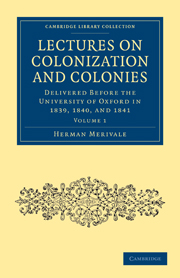 Lectures on Colonization and Colonies
Lectures on Colonization and Colonies Summary
I shall proceed to consider in order, in this part of my course, the different methods by which the requisite supply of labour has been procured in European colonies.
The expedient by means of which the earliest of modern European colonists made available for their service the rich territories they had subdued, was the labour of subjugated native races.
In various parts of their conquests, but more especially on the table lands of Mexico, Peru, and New Granada, or Cundinamarca, the Spaniards found the soil already cultivated by tribes advanced in civilization far beyond the ordinary condition of the natives of America. Into the curious problem of the origin and extent of that civilization it does not fall within my province to inquire. It has been exaggerated by some writers, but unduly depreciated by more. It is, at all events, clear, that they were so far advanced in industry and the mechanical arts as to be capable of developing to the utmost, under proper direction, the vast resources of their native regions.
But they were delivered over, in the defenceless state in which the conquest had left them, to the extremest tyranny which men, unrestrained by law or by religion could exercise. The sovereigns, nobles, and wealthy classes were destroyed, and their property confiscated. The commonalty passed through various degrees of servitude, beginning at the lowest and worst, and gradually emerging into a more mitigated condition.
- Type
- Chapter
- Information
- Lectures on Colonization and ColoniesDelivered before the University of Oxford in 1839, 1840, and 1841, pp. 269 - 291Publisher: Cambridge University PressPrint publication year: 2010First published in: 1841
